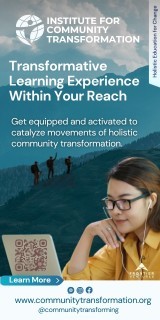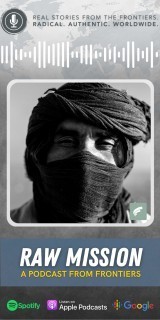The Person Not the Method
An Essential Ingredient for Catalyzing a Movement

Over a period of three years, I conducted empirical research[1] among effective movement catalysts to discover the traits and competencies possessed by pioneers effective in catalyzing a movement among a Muslim people group, and which traits they considered to have contributed to their catalyzing of a movement. This resulted in a profile of an effective movement catalyst, including eleven traits and competencies self-reported as exhibited by all participating effective catalysts.[2]
Leader Traits Verified to Fit 100% of all Catalysts
|
Hunger for God |
Catalysts hunger for depth with God, yearn to love him more deeply; they seek to hear God’s voice and be obedient. |
|
Expectant Faith |
Catalysts expect that God will grow a movement among their people group and save many soon, and they have great faith that God will show his power through their lives. |
|
Confidence |
Catalysts feel confident in their spiritual gifts and skills, and exhibit a sense of confidence. |
|
Drive for Responsibility |
Catalysts feel responsible for the people they serve and for engaging them with the good news; they are motivated by a sense of responsibility. |
|
Dependability |
Catalysts are reliable and trustworthy; others can depend on them. |
|
Persistence |
Catalysts are tenacious in spite of challenges and amidst difficulties; they don’t give up. |
|
Empowering |
Catalysts empower and enable local people to be the key players by putting responsibility and authority in their hands from the beginning and by developing their gifts. |
|
Confidence in the Holy Spirit |
Catalysts are confident in the Holy Spirit and have faith in him to accomplish his intended work in the life of all God’s children, as they are enabled to obey his commands. |
|
Confidence in the Bible |
Catalysts have deep confidence in the Bible to be their CPM guidebook, and deep assurance in its power to accomplish what God desires. |
|
Influencing Beliefs |
Catalysts talk often about their most important values and beliefs, consider the moral consequences of decisions with people, and emphasize the importance of living toward the purpose for which one is created. |
|
Inspiring of Vision |
Catalysts articulate a compelling vision of the future, talk enthusiastically about what needs to be accomplished to see a growing movement, and express confidence that goals will be achieved. |
Most literature on the subject of catalyzing a movement has focused on spiritual traits of the pioneer leader combined with the right methodology. David Garrison emphasizes characteristics of CPMs as well as methodology. The subtitles of his main publications are telling, as both refer to methods in the word “how”: “How God is Redeeming a Lost World”[3] and “How God is Drawing Muslims around the World to Faith in Jesus Christ.”[4] Garrison makes his approach sound comprehensive and absolute when insisting, “If one of these components is missing, you won’t get the results you desire” (292). He ascribes a crucial role to the pioneer leader (255), stating that “God has given Christians vital roles to play in the success or failure of these movements” (26); however, it is beyond the scope of his work to explore their traits or competencies.
The Watsons[5] and Jerry Trousdale[6] emphasize right methodology as well. Watsons qualify the significance of the methodological elements of the DMM approach: “This book focuses on the strategic elements you need to get a movement started. If you remove any of these elements, you won’t have a movement, period. You may have some growth, but you won’t experience a movement.”[7]
Watson regards the role of the external leader as critical, since he is the one who sparks the process of a movement (2011, 114). The main trait Watson highlights, a good character, is not verified as such by my research, but intersects strongly with Inspiring Personality, a trait verified in my research (exhibited by more than 80% of all catalysts interviewed), as well as some of the other traits: responsibility, dependability, and persistence. The relevance of character needs further study. Most of Watson’s competencies are either verified directly in this research (radical learning) or appear under competencies identified by this research, including the ability to develop potential beyond boundaries, the ability to delegate (empowering), and listening skills (personal consideration). Another competency identified by Watson, the ability to build teams, is very broad but encompasses a number of competencies identified by this research.
Steve Smith[8] likewise emphasized methodology; he presented a comprehensive, branded package by the name T4T. Smith made no explicit claim that his comprehensive methodology would guarantee a movement. The comprehensiveness of the approach, however, could easily leave the reader with that impression. For example, in a case study of an emerging movement, Smith described how he counselled the catalyst: “It wasn’t a CPM yet, but was getting close. As we listened, it was apparent that some elements of the T4T process were missing. We counselled him to incorporate the lessons from the next chapter.”[9]
In a separate publication, the only publication so far addressing exactly the topic of this study, Smith also considered the person of the pioneer leader.[10] Based on multiple case studies of dozens of practitioners, Smith’s summary of the traits and competencies of effective catalysts was that “each of them possesses a healthy combination of a set of characteristics.”[11] Most of those characteristics were verified by the empirical data of this present research.
Among the traits and competencies verified fully are: knowledge of reproduction principles, knowledge of movements, knowledge of what catalyzes movement (all under movement knowledge), lifelong learning, faith, expectant prayer (expectant faith and fervent intercession), and mentoring. Several other traits and competencies suggested by Smith are included within traits verified by this present research, such as knowledge of the Bible (under Bible teaching), tenacity and perseverance (persistence), integrity and spiritual authenticity (inspiring personality), loving God (hunger for God), being led by God, having vision from God, and exercising faith (expectant faith), bold discipling (discipling), ruthless self-evaluation (innovation and radical learning), training (Bible teaching, discipling, and coaching), developing leaders (confidence in nationals, and coaching), and vision casting (inspiring of vision). Only a few traits suggested by Smith are not directly verified to be strongly exhibited by movement catalysts: passionate urgency, single-mindedness, and exercising accountability.
The data of my research suggest that the effective catalyzing of movements is not tied to any particular methodology, though all employed reproductive movement approaches. Different effective catalysts employ different ministry approaches, both in terms of their movement methodology and in their approach to contextualization. A quarter of the catalysts participating in this study skipped the question about their ministry approach, which points to likely hesitation on their side to put their approach “into a box.” In addition, more than half of those who answered the question used the “Other” option to describe their ministry approach in their own words. Often the description given was a hybrid of two or more of the other approaches. This means that the approach of most effective catalysts in this study is a hybrid of more than one ministry approach, which they have adapted to the uniqueness of their context. The research does not support any claims that one specific ministry approach must be followed precisely to lead to a movement.
With the exception of the approach of adding Muslim Background Believers (MBBs) to existing Christian Background Believer (CBB) churches, it appears that particularity of methodology does not correlate to success in catalyzing a movement. By definition, the traditional approach (planting a single church) is not conducive to catalyzing a movement. This could explain why the pattern of adding MBBs to existing CBB churches is not utilized by any of the effective catalysts. At the same time, 13% of the catalysts employed the approach of planting a new church comprised of MBBs. This single church then reproduced itself and grew into a movement. The difference in these two approaches is not methodological, but primarily sociocultural. The adding of MBBs to CBB churches involves the bridging of divides, whether sociological, cultural, ethnic, or linguistic. These barriers explain why adding MBBs to existing CBB churches is not an effective approach for catalyzing a CPM, whereas the planting of a new MBB church may be.
Still, only 13% of all movements examined have been catalyzed with such an approach. The overwhelming majority of movements were catalyzed with one of the various movement approaches. Although the approaches used by effective catalysts differ in certain aspects, it is important to observe that all the approaches were reproductive movement approaches. These approaches have certain principles in common, which include cultural contextualization, obedience-oriented discipleship, house churches, reproduction, training of multipliers, and reproducible resources.[12]
The overall emphasis in pioneer and apostolic leadership and movement literature has been on right methodology, with some attention to leader traits and competencies of the pioneer leader or leaders, particularly traits of a spiritual nature. However, the findings of this research go beyond the commonly established insights of Christian pioneer leadership. The data clearly suggest that a particular methodology is far less significant in catalyzing movements than may have been assumed or publicized. The data of this study clearly establish that certain pioneer leader traits and competencies are strongly associated with effective catalyzing of CPMs. This perspective has been voiced by only a few, most notably Neill Mims and Bill Smith, who formulated what are considered to be among the most significant insights of almost 20 years of research into CPMs: “At the end of the day, it is the man and woman of God and not the method that God blesses.”[13] Another of the few voices who have expressed this perspective is movement thinker Dave Ferguson who concluded: “the greater the missional impact, the more obvious the pioneering apostolic leadership becomes.”[14]
The person of the pioneer leader(s), not the method he or she employs, plays the greatest role in determining whether or not a movement will result. Bill Smith is again among the few who formulated this accurate conclusion: “If someone says to me, give me the method or give me the curriculum, I know that they have not understood that this [the catalyzing of a movement] is accomplished through persons rather than methods.”[15] The right leader(s) will employ the right methodology. A pioneer leader with traits such as radical learning, intelligence, complex thinking, innovation, and initiative, who then possesses the necessary socio-influential and transformational competencies, has the best potential to identify and implement the most effective methodology for the context in which he or she is operating. However, a person who receives a certain methodology, but lacks the traits and competencies identified in this study, will be unable to effectively apply the methodology. This stands in stark contrast to the conclusions of many publications on movements that center around methods and principles rather than on the person of the catalyst. I hope the clear data of this research will jolt a paradigm shift in the field of catalyzing movements.
|
What do YOU think? We invite you to drop a note to [email protected]. Disagree? We would like to hear from you, to stimulate dialog about this topic. Agree? We would like to hear your insights on person over method, and on the traits of effective movement catalysts.
|
[1] A more in-depth discussion of the research methodology and conclusions can be found in my book Movement Catalysts: The Profile of the Leader God Uses to Catalyze Movements and in my chapter “The Profile of an Effective Movement Catalyst,” in Motus Dei, both forthcoming from William Carey Publishing. This research is ongoing, with an ever-growing sample of participants, and more findings to be published.
[2] The research identified a further list of traits of competencies exhibited consistently by most (defined as ≥80%) effective catalysts. This article, however, concentrates on those exhibited by all effective catalysts.
[3] Garrison, David 2004. Church Planting Movements: How God is Redeeming a Lost World. Midlothian: WIGTake Resources.
[4] Garrison, David 2014. A Wind in the House of Islam: How God is Drawing Muslims around the World to Faith in Jesus Christ. Midlothian: WIGTake Resources.
[5] Watson, David L. 2011. Gemeindegründungsbewegungen: Eine Momentaufnahme. 2nd edition. Schwelm: Deutsche Inland-Mission e. V. and Watson, David & Watson, Paul 2014. Contagious Disciple-Making: Leading Others on a Journey of Discovery. Nashville: Thomas Nelson.
[6] Trousdale, Jerry 2012. Miraculous movements: How Hundreds of Thousands of Muslims are Falling in Love with Jesus. Nashville: Thomas Nelson.
[7] Watson, 2014, 61.
[8] Smith, Steve & Kai, Ying 2011. T4T: A discipleship re-revolution. Monument: WIGTake Resources.
[9] Ibid, 119.
[10] Smith, Steve 2014. A profile of a movement catalyst. Mission Frontiers 36, 38-41.
[11] Ibid, 38.
[12] Betts, Trevor 2014. “Different Views of Essential Factors in CPMs. (Unpublished paper).
[13] Mims, Neill & Smith, Bill 2011. “Church Planting Movements: What have we Learned?” Mission Frontiers 33, 8.
[14] In Addison, Steve 2015. Pioneering movements: Leadership that multiplies disciples and churches. Downers Grove: IVP Books, 12.
[15] Ibid, 19.








comments